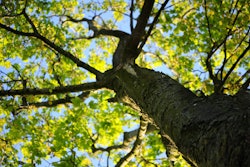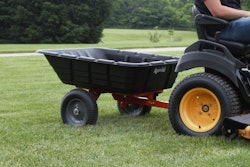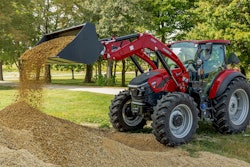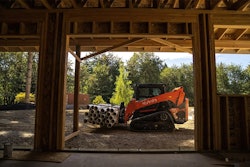When you consider all of the herbicides available for weed control, it’s no wonder that grounds managers have come to rely on them as part of their turf management practices. Comprising a significant portion of the chemical market are post-emergence herbicides, which are formulated to knock down weeds that are already visible in the landscape. These herbicides are relatively inexpensive and effective in their control of annual broadleaf weeds, insuring their popularity with landscape contractors throughout the United States.
As spring approaches, summer annual weeds (such as goosegrass, crabgrass, foxtails and spurge) will begin to germinate, preparing for active growth during the summer. They will complete their lifecycle in a single growing season. For post-emergence herbicides to be most effective against these weeds, you need to use them during the time of year when the weeds are actively growing (usually when air temperatures are between 40 degrees and 80 degrees Fahrenheit and soil moisture is good). Doing so optimizes control because weed growth encourages herbicide translocation through the entire plant. If you wait until the end of the lifecycle when the broadleaf weeds begin flowering, herbicide efficacy will be compromised because the weed will be sending all of its resources to the shoots for flower production. Also, the younger the weed, the weaker the root system and the more susceptible to herbicide it is. This means that for summer annual weeds, mid- to late-spring applications work best in warm-season turf. If you have to delay your application, know that the herbicide can still be effective against annual broadleaf weeds, but it may require multiple applications.
Unless you have a very large area to cover or are worried about drift, select a post-emergence herbicide in a spray formulation. Sprays cover weed foliage more thoroughly and you’ll get more consistent results. And adding a surfactant can improve the coverage even more. If you choose to use a granular formulation, apply the herbicide when foliage is wet so that it will adhere to the leaves.
Finally, limit mowing and irrigation when timing herbicide applications. Don’t mow turf areas within 24 to 48 hours before or after applying herbicides. Mowing before an application will reduce the weed’s surface area, limiting the herbicide’s contact with the weed and making it less effective. Mowing directly following an application will limit the weed’s uptake of the herbicide. Irrigating within 24 hours after applying an herbicide can wash it off the weed, making it less effective.
Remember that label instructions are the ultimate guide to proper use of pesticides. Always read and follow label instructions for each chemical you use.
TRY THIS: Go back to nature for effective weed control tactics
There are numerous products out there to keep you on track with weed control. Most are easy to use and some are relatively inexpensive. These elements make it easy to overlook the most effective weed control program: proper cultural management of turfgrass. Making turf as healthy as it can be can constitute an effective way to eliminate weeds or, at the very least, cut down on need for chemical applications to control them. You should know that weeds aren’t the cause of weak turf, but the result of weak turf. The best defense against weeds is a healthy, dense turfgrass that can out-compete them.
To develop a cultural management program that will fend-off weeds, you’ll need to consider mowing height, rate and timing of fertilization and irrigation, aeration and even the selection of turfgrass (for shady vs. sunny areas). While each of these components could merit an entire article, here is a brief overview that highlights the concepts you should incorporate into your turf management program.
- Mowing height. By mowing turf short, you take away some of its strength. If your customers will let you maintain turf at a longer length, say 2 to 3 inches, it will be healthier and better compete against weeds.
- Fertilization. Studies have shown that maintaining soil fertility can optimize turf and minimize weeds. Fertilizing at higher rates in some cases suppresses weeds. But this is a balancing act. Too much fertilizer can make your turf susceptible to disease. It’s best to let soil be your guide. Test it to determine fertilization requirements.
- Irrigation. Obviously, drought-stressed turf is not going to compete well against weeds. This is one of the leading causes of weed infestation. Irrigate in the early morning and at an amount that replaces moisture lost through evaporation and transpiration. But irrigate too much and you run the risk of promoting turf disease. If you’re not sure about irrigation rates, you can learn more about them by logging on to the Irrigation Association’s Web site at www.irrigation.org.
- Aeration. To ensure that water and nutrients are reaching turfgrass roots, it may be necessary to aerate during the spring and/or fall. Compaction and thatch can prohibit irrigation and fertilization efforts, leading to drought stress and altered pH. Through aeration, you’ll increase water and nutrient movement, as well as an increase in oxygen levels.
- Turf selection. A turfgrass that is appropriate for its location will automatically require less coddling and generally be less weedy. When choosing a turf (or replacement turf), consider whether it’s going in a sunny or shady area that is low- or high-traffic.
ASK THE EXPERT: Don Myers, Bayer
When is the most effective time of year to use post-emergence herbicides?
Post-emergent products are applied when weeds are actually present. Usually it is easy to kill the weeds when they are small. Sometimes a fall application is good with certain hard-to-control weeds such as dallisgrass.
How do you choose the best method of application?
The method of application depends on the formulation. Granule applications are made with various types of spreaders. The objective, most often, is to get the particles to the soil surface. Many liquid applications are applied with a small backpack sprayer or larger sprayer, depending on the surface area to be treated. Some liquid applications are intended for use on the soil, but more often the plant itself is the primary target. Proper water volume and plant coverage can by very important to achieve maximum effect.
Should the mowing and aerating schedule change if applying post-emergence herbicides?
It is often a good idea to delay mowing to allow the herbicide to be absorbed by the plant for a day or so after application. This will benefit efficacy. Aeration stresses the turf and so do some herbicide applications. Thus, it is a good idea to separate aeration from herbicide application to minimize the stress and maintain optimum turf quality.
PRODUCT NEWS: Armada fungicide registered for ornamentals
Bayer Environmental Science’s Armada, a broad-spectrum fungicide, is approved for control of foliar diseases of ornamental plants and trees. Applied as a foliar spray, Armada controls anthracnose, black spot, downy mildew, leaf spot, powdery mildew, rust and scab. Use rates vary from 3 oz. to 9 oz. per 100 gallons of spray solution and may be applied in 14- to 28-day intervals. The fungicide may be used for preventive and curative disease control on plants such as chrysanthemums, geraniums and marigolds.











